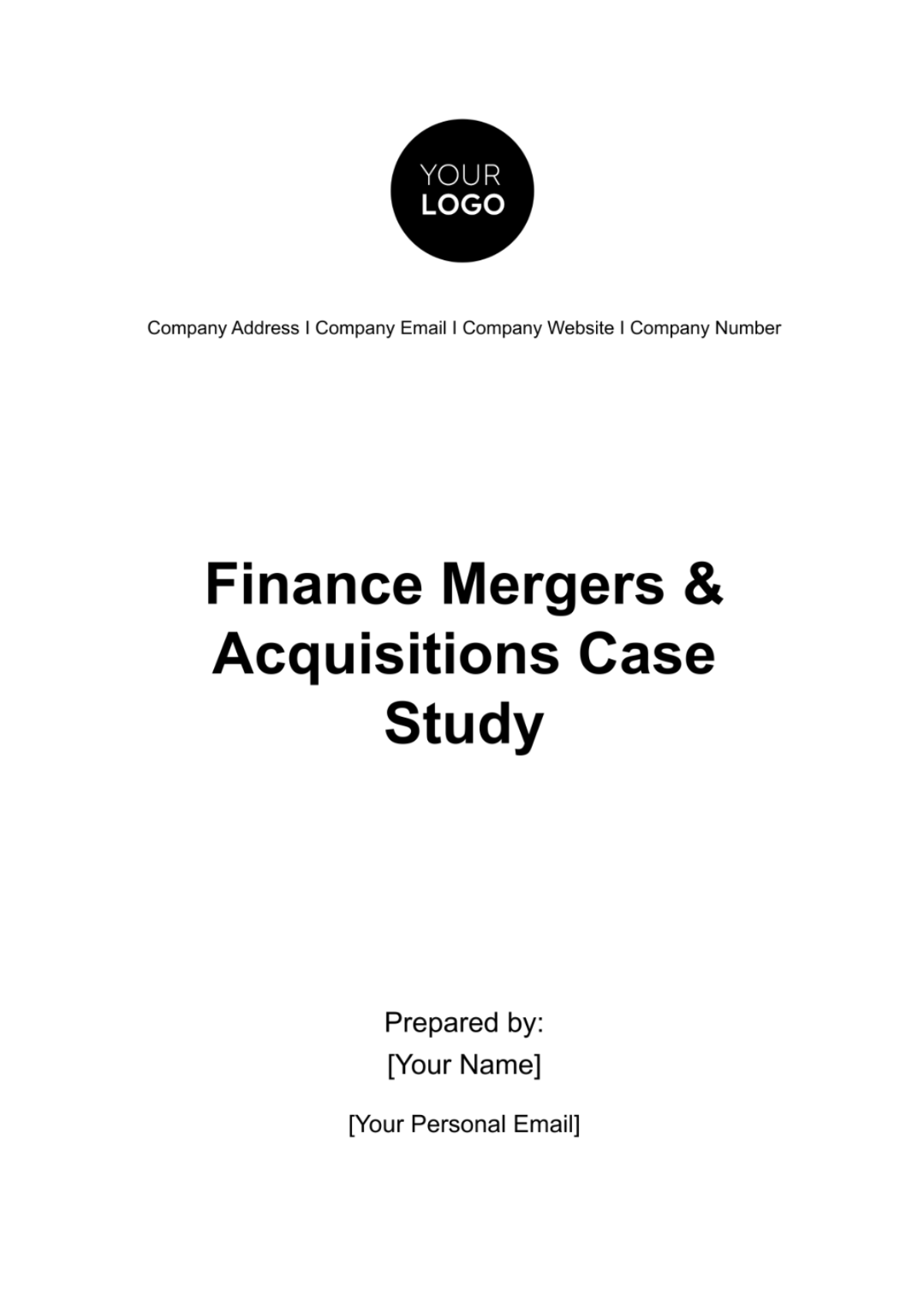Free Finance Mergers & Acquisitions Case Study

I. Introduction
In [Year], [Your Company Name], a well-established player in the competitive banking sector, strategically positioned itself for future growth through the acquisition of [Your Partner Company Name / Second Party], a regional financial institution with a strong emphasis on digital innovation. The decision to explore this transformative merger was driven by [Your Company Name]'s vision to not only expand its market footprint but also to emerge as a leader in the rapidly evolving digital banking landscape. This case study delves into the intricate details of the merger, from its initial conceptualization to the execution phase, unraveling the strategic imperatives, challenges encountered, and the profound impact on the financial industry.
II. Background and Context
Acquiring Company: [Your Company Name]
[Your Company Name], a stalwart in the banking arena, boasted a national presence and a legacy of financial stability. The institution, driven by a forward-looking leadership, sought to reinforce its position as a market leader by strategically leveraging the strengths and capabilities of a synergistic partner.
Target Company: [Your Partner Company Name / Second Party]
[Your Partner Company Name / Second Party], a regional powerhouse known for its prowess in digital banking solutions, represented a unique opportunity for [Your Company Name]. Beyond its regional success, [Your Partner Company Name / Second Party] had cultivated a reputation for innovation, making it an ideal candidate for a strategic alliance that could unlock new avenues for growth.
Industry Analysis
Amidst the dynamic landscape of the banking sector characterized by technological disruptions and evolving customer preferences, [Your Company Name] recognized the need to adapt. The industry analysis revealed an intensified competition for digital services, prompting [Your Company Name] to explore strategic collaborations as a catalyst for sustained and future-proofed success.
III. Rationale for M&A
Strategic Alignment
[Your Company Name]'s pursuit of the [Your Partner Company Name / Second Party] merger was anchored in a strategic vision to transcend traditional banking and embrace the digital future. Recognizing the rapid evolution of customer expectations, [Your Company Name] aimed to position itself as an industry leader in digital banking. The strategic alignment between the two entities was not merely about market expansion; it was a deliberate move to synergize their strengths and capitalize on the emerging opportunities in the digital financial landscape.
Synergies and Benefits
The merger aimed to unlock a myriad of synergies and benefits. Beyond the operational efficiencies, the integration of [Your Partner Company Name / Second Party]'s digital prowess with [Your Company Name]'s extensive reach was projected to create a comprehensive ecosystem. This envisioned synergy went beyond immediate cost savings; it sought to establish a dynamic platform for sustained innovation, cross-selling, and enhanced customer experiences, aligning with the long-term goals of both organizations.
IV. Due Diligence
Comprehensive Analysis
[Your Company Name]'s due diligence process was a comprehensive exploration into the intricate details of [Your Partner Company Name / Second Party]'s operations. Financial health, regulatory compliance, and potential legal implications were scrutinized. The goal was not just risk mitigation but also the identification of opportunities. Through this thorough analysis, [Your Company Name] ensured that the merger would not only be seamless but also strategically advantageous in the ever-evolving financial landscape.
Opportunities Uncovered
In the due diligence phase, unexpected opportunities emerged. [Your Partner Company Name / Second Party]'s advanced digital platforms revealed untapped potential for innovation and growth. These opportunities went beyond the immediate scope of the merger, providing insights that would shape the future strategic direction of the combined entity.
V. Valuation
Valuation Methods
The valuation of [Your Partner Company Name / Second Party] was conducted with precision, utilizing a combination of discounted cash flow (DCF) and comparable company analysis (CCA). This hybrid approach ensured a nuanced understanding of [Your Partner Company Name / Second Party]'s intrinsic value, considering both quantitative and qualitative factors. The thoroughness of the valuation process underscored [Your Company Name]'s commitment to arriving at a fair and informed offer reflective of the strategic importance of the acquisition.
Fairness Evaluation
Recognizing the significance of an unbiased perspective, independent financial advisors were engaged to conduct a fairness evaluation. This step was integral in instilling confidence among shareholders of both [Your Company Name] and [Your Partner Company Name / Second Party], ensuring that the deal was not only financially equitable but also aligned with principles of fairness and corporate governance.
VI. Deal Structure
Consideration Mix
The deal structure was meticulously crafted to align with the strategic objectives of both entities. A combination of cash and [Your Company Name]'s common stock was chosen to provide immediate value to [Your Partner Company Name / Second Party] shareholders while maintaining alignment with [Your Company Name]'s financial strategy. Contingencies were intelligently integrated, linking certain components of the consideration to post-merger performance metrics, fostering a shared commitment to long-term success.
Alignment with Strategy
The deal structure wasn't merely a financial arrangement; it was a manifestation of strategic foresight. Balancing immediate financial impact with long-term value creation, the deal structure aimed not only to satisfy stakeholders but also to set the stage for a harmonious integration that would capitalize on the synergies envisioned during the strategic alignment phase.
VII. Financing
Funding Sources
[Your Company Name]'s financing strategy was a blend of financial instruments, including existing cash reserves, debt, and a secondary stock offering. This diversified approach was aimed at optimizing the capital structure, ensuring minimal dilution of existing shareholders while fortifying [Your Company Name]'s financial position for the challenges and opportunities that lay ahead.
Financial Impact
Beyond the immediate financial impact, the financing strategy was designed to strategically position [Your Company Name] for sustained growth. Mitigating the short-term effects on shareholder value, the financing approach aimed to create a robust financial foundation for the merged entity, facilitating seamless integration and future strategic initiatives.
VIII. Regulatory and Legal Considerations
Regulatory Approvals
Navigating the complex regulatory landscape, [Your Company Name] successfully secured approvals from relevant authorities, ensuring compliance with stringent banking regulations and antitrust requirements. The strategic foresight exhibited in anticipating and addressing potential regulatory challenges played a pivotal role in expediting the approval process. The collaborative engagement with regulatory bodies underscored [Your Company Name]'s commitment to transparency and adherence to legal frameworks, establishing a solid foundation for the merger.
Legal Challenges
The merger process encountered legal complexities that were adeptly managed through meticulous negotiation of contracts and agreements. Legal challenges ranged from ensuring the protection of intellectual property rights to addressing potential disputes arising from the integration process. The legal team's proficiency in navigating these challenges not only safeguarded the interests of both [Your Company Name] and [Your Partner Company Name / Second Party] but also set a precedent for best practices in managing legal aspects of complex financial transactions.
IX. Integration Plan
Comprehensive Strategy
The integration plan was a detailed roadmap outlining the seamless combination of [Your Company Name] and [Your Partner Company Name / Second Party]. It addressed technology integration challenges, streamlined operational processes, and laid out a blueprint for fostering a unified corporate culture. The comprehensive strategy aimed not only at maximizing synergies but also at minimizing disruptions to customer service and internal operations, ensuring a smooth transition.
Cultural Alignment
Recognizing the significance of organizational culture, efforts were made to bridge cultural differences between [Your Company Name] and [Your Partner Company Name / Second Party]. Open communication channels, leadership workshops, and cross-functional collaboration initiatives were implemented to foster a shared sense of purpose and values. This cultural alignment played a pivotal role in creating a cohesive and motivated workforce within the merged entity.
X. Post-Merger Performance
Financial Outcomes
Post-merger, the combined entity showcased robust financial outcomes exceeding initial projections. Cost synergies were realized through the efficient integration of operations, contributing to improved profitability. The financial performance not only validated the strategic rationale behind the merger but also instilled confidence among shareholders and stakeholders in the sustainability of the newly formed entity.
Operational Excellence
Streamlining processes and integrating digital platforms resulted in operational excellence, enhancing customer experiences and internal efficiencies. The amalgamation of [Your Company Name]'s established infrastructure with [Your Partner Company Name / Second Party]'s innovative solutions led to a strengthened operational backbone, positioning the merged entity as a dynamic force in the competitive financial services landscape.
Lessons Learned
The post-merger phase provided invaluable lessons for [Your Company Name]'s leadership. While successes were celebrated, challenges in technology integration highlighted the importance of meticulous planning and stakeholder communication. These insights served as a foundation for continuous improvement and informed decision-making in future strategic initiatives.
XI. Conclusion
In conclusion, the merger between [Your Company Name] and [Your Partner Company Name / Second Party] stands as a landmark achievement, encapsulating strategic foresight, meticulous planning, and successful execution. This case study unveils the nuanced dynamics of finance mergers and acquisitions, emphasizing the importance of aligning strategic objectives, navigating regulatory landscapes, and prioritizing cultural integration. The seamless post-merger performance, characterized by robust financial outcomes and operational excellence, not only validated the strategic rationale but positioned the merged entity as an industry leader. The lessons learned from this transformative endeavor serve as a blueprint for future initiatives, reinforcing the significance of adaptability, effective communication, and continuous improvement in navigating the ever-evolving landscape of the financial services sector. This case study contributes valuable insights to professionals, academics, and organizations contemplating similar strategic moves in the realm of finance.
- 100% Customizable, free editor
- Access 1 Million+ Templates, photo’s & graphics
- Download or share as a template
- Click and replace photos, graphics, text, backgrounds
- Resize, crop, AI write & more
- Access advanced editor
Discover unparalleled insights with the Finance Mergers & Acquisitions Case Study Template from Template.net. This editable and customizable template, powered by the advanced AI Editor Tool, streamlines your analysis. Craft compelling narratives around strategic rationales, financial valuations, and risk assessments effortlessly. Elevate your M&A understanding – your blueprint for mastering finance's dynamic landscape is just a click away.





























